Text
Final Semester Blog, Pre Production FINALIZATION
Dev Blog #22 – Project Initiation & Additional Aspirations

As I bring the pre-production phase of Timeless Epoch to a close, I find myself not only prepared to begin—but deeply energized by the journey ahead. Over the past few weeks, I've laid the foundation for a project that will act as the centerpiece of my final MA showcase. But just as importantly, this phase has sparked a hunger to push beyond my original scope, and aim even higher.
Project Initiation: From Planning to Action

With timelines and deliverables firmly in place, the project is officially underway. I've planned out everything from modular kit development to the integration of a procedural content generation (PCG) system, and even penciled in time for key side projects to develop specific skill sets. The technical prep is done. The reference libraries are built. And the goals are clear.
But something interesting happened during the final stretch of planning: the more confident I grew in the scope I had defined, the more I started to think about what else I could do. This has led me to a set of additional goals—a few more ambitious objectives that will both challenge me and further enhance the final quality and versatility of the Timeless Epoch experience.
Additional Goals: Expanding the Vision
1. Multiple Architectural Styles
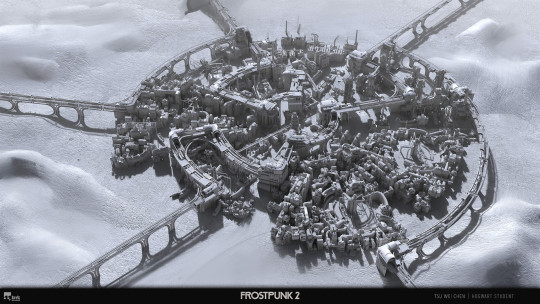
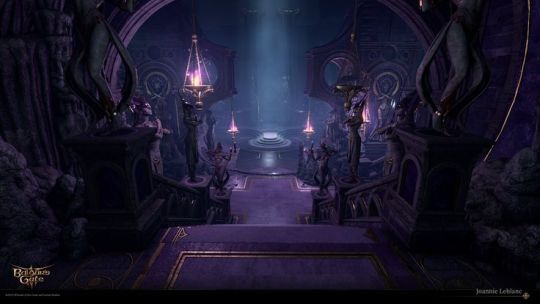
While my core modular asset kit is rooted in a medieval aesthetic, I’ve realized that exploring alternate architectural styles could greatly expand the creative and functional possibilities of the project. In particular, I’m considering:
A fantasy-style set with ornate designs, perhaps inspired by elvish or gothic-fantastical architecture.
A steampunk or industrial-themed modular kit, bringing in elements like metal beams, gears, smokestacks, and rusted rivets.
Not only would this push my modeling and texturing skills into new territory, but it would also align beautifully with the narrative of Timeless Epoch—a world where civilizations from different timelines converge.
2. A Smarter, More Functional PCG System



The first iteration of my PCG system focuses on structure generation—placing walls, roofs, and doorways to form basic buildings. But the real magic will come from taking that further. My new goal is to enhance the system to populate interiors using furniture, props, and lighting from my decorative asset collection.
If time allows, I’ll take it a step further by exploring how the system could designate specific rooms—such as storage spaces, kitchens, or halls—and populate them accordingly. This would shift my PCG tool from being just a structure generator into a truly environment-aware builder.
3. Sculptural Additions

Another new direction I’m eager to pursue is sculpting. The idea here is to create a small number of unique sculptures—be they decorative busts, statues, or mystical relics—that can be integrated into the environments as both aesthetic and narrative anchors. These sculptural elements will allow me to bring more variety and personality into the spaces and test my sculpting pipeline in the process.
Looking Ahead
Despite still being in the early stages, I feel like I’ve already grown so much. Pre-production has been about more than just planning—it’s been a process of rediscovering what excites me about environment art, and recommitting to continuous improvement. Whether it’s through building smarter systems or exploring new styles, I want this project to reflect not just where I am now, but where I’m heading.
I’m excited. Nervous. Motivated. Ready. Let the real work begin.
Resources:
Adobe Substance 3D (2024). Adobe Substance 3D Designer for Beginners | Course Overview | Adobe Substance 3D. [online] YouTube. Available at: https://www.youtube.com/watch?v=At3FoFcuN6k&list=PLB0wXHrWAmCxBw92VSRjqsbqYXgkF8puC
ArtStation. (2025). A Plague Tale: Requiem - Chapter III, Olivier Cannone. [online] Available at: https://www.artstation.com/artwork/4XKW5Y [Accessed 23 Apr. 2025].
ArtStation. (2025). A Plague Tale: Requiem – Concept arts part 2, Tom Hisbergue. [online] Available at: https://www.artstation.com/artwork/140zlZ [Accessed 23 Apr. 2025].
ArtStation. (2025). Frostpunk 2: Environment Concept Arts, ZooWe (Tsu-Wei) Chen. [online] Available at: https://www.artstation.com/artwork/3EeBgo [Accessed 23 Apr. 2025].
ArtStation. (2025). Isaac Oster. [online] Available at: https://www.artstation.com/isaacoster [Accessed 23 Apr. 2025].
ArtStation. (2025). Jef Simons. [online] Available at: https://www.artstation.com/jef_simons [Accessed 23 Apr. 2025].
ArtStation. (2025). joannie leblanc. [online] Available at: https://www.artstation.com/joannie [Accessed 23 Apr. 2025].
ArtStation. (2025). Michael Chae. [online] Available at: https://www.artstation.com/michaelchae [Accessed 23 Apr. 2025].
Artstation.com. (2025). Page Restricted. [online] Available at: https://www.artstation.com/tonch-la-gonch [Accessed 23 Apr. 2025].
ArtStation. (2025). Shinta Lyu. [online] Available at: https://www.artstation.com/kiritsugu [Accessed 23 Apr. 2025].
ArtStation. (2025). Tanguy Talbert. [online] Available at: https://www.artstation.com/gaxxx [Accessed 23 Apr. 2025].
ArtStation. (2025). TRACE studio. [online] Available at: https://www.artstation.com/trace_studio [Accessed 23 Apr. 2025].
ArtStation. (2025). V Rising - Environment Props, Linn Wilhelmsson. [online] Available at: https://www.artstation.com/artwork/rlDqVO [Accessed 23 Apr. 2025].
baldursgate3.game. (n.d.). Baldur’s Gate 3. [online] Available at: https://baldursgate3.game
Epic Games (2024). Procedural Content Generation Overview | Unreal Engine 5.5 Documentation | Epic Developer Community. [online] Epic Games Developer. Available at: https://dev.epicgames.com/documentation/en-us/unreal-engine/procedural-content-generation-overview
OpenAI (2025). ChatGPT. [online] chatgpt.com. Available at: https://chatgpt.com.
Procedural Minds - YouTube. Creating Procedural Content. [online] Available at: https://www.youtube.com/@Procedural_Minds
Stuart, K. (2022). A beginner’s guide to Elden Ring: what it is and why you should play it. The Guardian. [online] 2 Mar. Available at: https://www.theguardian.com/games/2022/mar/02/elden-ring-beginners-guide-open-world-adventure
Substance Painter 2021. Getting Started - Course Introduction. [online] Available at: https://www.youtube.com/watch?v=-ZbmRsOnApk&list=PLB0wXHrWAmCwnqWfKdGEmbtSKN2EzvLrY
UNF Games (2024). Creating a village using Procedural Generation PCG in Unreal Engine 5 - Beginner Tutorial. [online] YouTube. Available at: https://www.youtube.com/watch?v=E5tsS-5sYYo [Accessed 23 Dec. Mar]
www.focus-entmt.com. (n.d.). A Plague Tale: Requiem - Focus Entertainment. [online] Available at: https://www.focus-entmt.com/en/games/a-plague-tale-requiem
War:, T. (2022). Total War: WARHAMMER III - Home. [online] Totalwar.com. Available at: https://warhammer3.totalwar.com [Accessed 23 Apr. 2025].
0 notes
Text
Development Blog: Timeless Epoch
Blog #21 – Inspirational Spotlight: Raveen Pathirana’s “Medieval Environment – UE4”
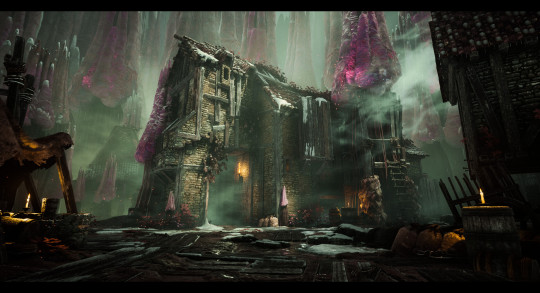
Every now and then, you come across an artwork that instantly resonates with your vision—where each brick, each texture, and each lighting cue feels like it's whispering the same story you're trying to tell. That’s exactly what happened when I stumbled across Rabeen Pathirana’s “Medieval Environment - UE4” project on ArtStation.
I actually first discovered Rabeen’s work on Polycount, and I was immediately drawn in by the stunning architectural detail. His environment design manages to strike a perfect balance between realism and artistry—a kind of immersive storytelling through form and material. It’s not just a beautiful scene, but a tangible one. You can almost feel the damp stone and hear the creak of wooden beams. For someone like me who is crafting a medieval-styled modular asset kit, this was an absolute goldmine of reference and inspiration.
Architectural Excellence and Modular Brilliance
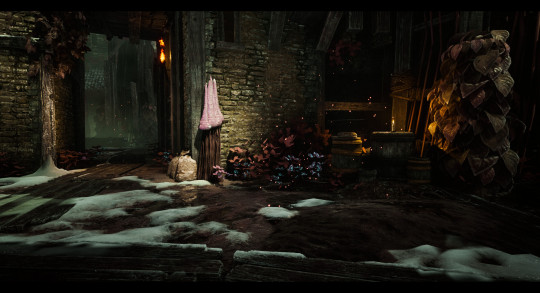
Rabeen’s architectural approach demonstrates a deep understanding of modularity. His pieces feel like they could be slotted together into any configuration and still look natural and coherent. This modular clarity is crucial for my Timeless Epoch project. I'm aiming to build structures that allow flexibility but don’t compromise on historical or artistic integrity. His work gave me a blueprint for how to maintain a strong visual identity while keeping the kit functional and adaptable.
Texture Work That Tells Stories
The next standout for me was the texturing. The worn cobblestones, the moss creeping up stone walls, the faded paint on wood—all of it feels aged, weathered, and historically grounded. I’m currently improving my own texturing skills using Adobe Substance Painter and Designer, and looking at how Rabeen approached this gave me direction. His surfaces feel rich with narrative, which is exactly what I want from the assets in Timeless Epoch. A broken wall should hint at war or time; a pristine pillar should feel out of place unless there’s a reason for it. Textures should be more than just decorative—they should feel alive.
Masterful Post-Processing and Presentation
But what truly elevates Rabeen’s work is the post-processing. The lighting, color grading, and subtle atmospheric effects like fog and bloom aren’t just afterthoughts—they are integral to the storytelling. His renders transform static meshes into living spaces. That’s the bar I’m setting for my own final renders and scene compositions. Presentation is everything, and he’s shown how even modest assets can be made to shine through careful composition and post-processing polish.
A Benchmark and a Goalpost
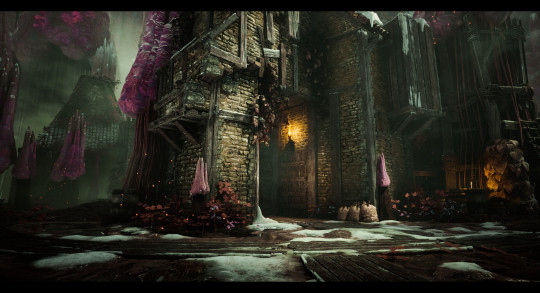
This project has become one of my primary visual references for the medieval modular kit I’m currently developing. It’s a benchmark I look at when I’m feeling unsure about my aesthetic direction or when I want to remind myself of the quality I’m aiming for. More than that, Rabeen’s work reminds me why I love environment art—it’s not just about technical prowess, but about evoking a world, a time, a place.
As I move forward with Timeless Epoch, I hope to create something that even scratches the surface of the atmosphere and depth Rabeen was able to achieve. His work has not only inspired my modular kit’s style but also challenged me to think more carefully about material storytelling and environmental tone.
Resources:
Adobe Substance 3D (2024). Adobe Substance 3D Designer for Beginners | Course Overview | Adobe Substance 3D. [online] YouTube. Available at: https://www.youtube.com/watch?v=At3FoFcuN6k&list=PLB0wXHrWAmCxBw92VSRjqsbqYXgkF8puC
ArtStation. (2025). A Plague Tale: Requiem - Chapter III, Olivier Cannone. [online] Available at: https://www.artstation.com/artwork/4XKW5Y [Accessed 23 Apr. 2025].
ArtStation. (2025). A Plague Tale: Requiem – Concept arts part 2, Tom Hisbergue. [online] Available at: https://www.artstation.com/artwork/140zlZ [Accessed 23 Apr. 2025].
ArtStation. (2025). Frostpunk 2: Environment Concept Arts, ZooWe (Tsu-Wei) Chen. [online] Available at: https://www.artstation.com/artwork/3EeBgo [Accessed 23 Apr. 2025].
ArtStation. (2025). Isaac Oster. [online] Available at: https://www.artstation.com/isaacoster [Accessed 23 Apr. 2025].
ArtStation. (2025). Jef Simons. [online] Available at: https://www.artstation.com/jef_simons [Accessed 23 Apr. 2025].
ArtStation. (2025). joannie leblanc. [online] Available at: https://www.artstation.com/joannie [Accessed 23 Apr. 2025].
ArtStation. (2025). Michael Chae. [online] Available at: https://www.artstation.com/michaelchae [Accessed 23 Apr. 2025].
Artstation.com. (2025). Page Restricted. [online] Available at: https://www.artstation.com/tonch-la-gonch [Accessed 23 Apr. 2025].
ArtStation. (2025). Shinta Lyu. [online] Available at: https://www.artstation.com/kiritsugu [Accessed 23 Apr. 2025].
ArtStation. (2025). Tanguy Talbert. [online] Available at: https://www.artstation.com/gaxxx [Accessed 23 Apr. 2025].
ArtStation. (2025). TRACE studio. [online] Available at: https://www.artstation.com/trace_studio [Accessed 23 Apr. 2025].
ArtStation. (2025). V Rising - Environment Props, Linn Wilhelmsson. [online] Available at: https://www.artstation.com/artwork/rlDqVO [Accessed 23 Apr. 2025].
baldursgate3.game. (n.d.). Baldur’s Gate 3. [online] Available at: https://baldursgate3.game
Epic Games (2024). Procedural Content Generation Overview | Unreal Engine 5.5 Documentation | Epic Developer Community. [online] Epic Games Developer. Available at: https://dev.epicgames.com/documentation/en-us/unreal-engine/procedural-content-generation-overview
OpenAI (2025). ChatGPT. [online] chatgpt.com. Available at: https://chatgpt.com.
Procedural Minds - YouTube. Creating Procedural Content. [online] Available at: https://www.youtube.com/@Procedural_Minds
Stuart, K. (2022). A beginner’s guide to Elden Ring: what it is and why you should play it. The Guardian. [online] 2 Mar. Available at: https://www.theguardian.com/games/2022/mar/02/elden-ring-beginners-guide-open-world-adventure
Substance Painter 2021. Getting Started - Course Introduction. [online] Available at: https://www.youtube.com/watch?v=-ZbmRsOnApk&list=PLB0wXHrWAmCwnqWfKdGEmbtSKN2EzvLrY
UNF Games (2024). Creating a village using Procedural Generation PCG in Unreal Engine 5 - Beginner Tutorial. [online] YouTube. Available at: https://www.youtube.com/watch?v=E5tsS-5sYYo [Accessed 23 Dec. Mar]
www.focus-entmt.com. (n.d.). A Plague Tale: Requiem - Focus Entertainment. [online] Available at: https://www.focus-entmt.com/en/games/a-plague-tale-requiem
War:, T. (2022). Total War: WARHAMMER III - Home. [online] Totalwar.com. Available at: https://warhammer3.totalwar.com [Accessed 23 Apr. 2025].
0 notes
Text
Development Blog: Timeless Epoch
Blog # 20: Project Deliverables and Creative Milestones
Following the timeline, it’s important to define what exactly Timeless Epoch aims to deliver. With multiple moving parts—ranging from system design to modular modeling and scene decoration—this entry outlines the project’s core outputs and highlights three key side projects that will function as skill-building milestones.
1. The PCG System – Function Over Flair

The PCG system is designed to create structural building layouts automatically, using a modular kit I’ve built from scratch. It’s intended to be lightweight, functional, and scalable.
Baseline Features:

Generates enclosed structures using base modular components (walls, floors, roofs, doorways).
Snapping logic to ensure assets align correctly on a grid.
Optional Stretch Goals:
Boundary gravel or decorative terrain decals placed automatically.
Basic interior decoration (e.g., inserting tables, crates, or lighting).
Multiple architecture sets (supporting future expansions).
This system forms the foundation of the final city scene and will demonstrate technical competency in procedural logic and environment construction.
2. The Modular Asset Kit – The Heart of the Project

The modular kit is the most intensive deliverable. It needs to be consistent, visually compelling, and functionally modular.
Core Components:
Walls (solid, broken, windowed)
Roofs (standard and destructible)
Doorways and arches
Pillars and columns
Floors and foundations
Potential Additions (Time-Dependent):
Damaged or overgrown variants
Architectural flourishes like trims or corbels
Window inserts or portcullises
This kit will not only support the PCG system but also showcase my ability to maintain aesthetic consistency while building for flexibility.
3. Decorative Items – Flexibility and Storytelling

Decorative props will be used to enhance atmosphere and context within scenes. These are less technically rigid but are vital for environmental storytelling.
Planned Prop Categories:
Lighting: Chandeliers, torches, sconces
Furniture: Tables, benches, storage
Environmentals: Banners, fences, rubble, glasswork
These will be either placed manually or fed into spawn logic within the PCG framework, depending on time and complexity.
4. Side Projects – Skill Development and Narrative Markers
In addition to the mainline deliverables, I’ll be completing three targeted side projects, each focusing on a different key discipline:
Medieval Wall Texture (2–3 days) Created in Substance Designer to deepen my understanding of material blending and pattern logic.
Hero Prop (3 days) A sculpted and textured centerpiece for the world of Timeless Epoch. This object will carry symbolic or narrative significance—perhaps a ceremonial relic, throne, or ruined artifact.
Procedural City Scene (3–4 days) A final test of the PCG system and modular kit. This scene will act as a culminating showcase piece, demonstrating that the tools and assets developed throughout the project can create compelling and believable worlds.
Together, these deliverables aim to show a complete pipeline: from ideation and tool design to asset creation and final presentation. Each element is crafted not just to fulfill academic criteria but to act as a stepping stone toward professional work in environment design and technical art.
Resources:
Adobe Substance 3D (2024). Adobe Substance 3D Designer for Beginners | Course Overview | Adobe Substance 3D. [online] YouTube. Available at: https://www.youtube.com/watch?v=At3FoFcuN6k&list=PLB0wXHrWAmCxBw92VSRjqsbqYXgkF8puC
ArtStation. (2025). A Plague Tale: Requiem - Chapter III, Olivier Cannone. [online] Available at: https://www.artstation.com/artwork/4XKW5Y [Accessed 23 Apr. 2025].
ArtStation. (2025). A Plague Tale: Requiem – Concept arts part 2, Tom Hisbergue. [online] Available at: https://www.artstation.com/artwork/140zlZ [Accessed 23 Apr. 2025].
ArtStation. (2025). Frostpunk 2: Environment Concept Arts, ZooWe (Tsu-Wei) Chen. [online] Available at: https://www.artstation.com/artwork/3EeBgo [Accessed 23 Apr. 2025].
ArtStation. (2025). Isaac Oster. [online] Available at: https://www.artstation.com/isaacoster [Accessed 23 Apr. 2025].
ArtStation. (2025). Jef Simons. [online] Available at: https://www.artstation.com/jef_simons [Accessed 23 Apr. 2025].
ArtStation. (2025). joannie leblanc. [online] Available at: https://www.artstation.com/joannie [Accessed 23 Apr. 2025].
ArtStation. (2025). Michael Chae. [online] Available at: https://www.artstation.com/michaelchae [Accessed 23 Apr. 2025].
Artstation.com. (2025). Page Restricted. [online] Available at: https://www.artstation.com/tonch-la-gonch [Accessed 23 Apr. 2025].
ArtStation. (2025). Shinta Lyu. [online] Available at: https://www.artstation.com/kiritsugu [Accessed 23 Apr. 2025].
ArtStation. (2025). Tanguy Talbert. [online] Available at: https://www.artstation.com/gaxxx [Accessed 23 Apr. 2025].
ArtStation. (2025). TRACE studio. [online] Available at: https://www.artstation.com/trace_studio [Accessed 23 Apr. 2025].
ArtStation. (2025). V Rising - Environment Props, Linn Wilhelmsson. [online] Available at: https://www.artstation.com/artwork/rlDqVO [Accessed 23 Apr. 2025].
baldursgate3.game. (n.d.). Baldur’s Gate 3. [online] Available at: https://baldursgate3.game
Epic Games (2024). Procedural Content Generation Overview | Unreal Engine 5.5 Documentation | Epic Developer Community. [online] Epic Games Developer. Available at: https://dev.epicgames.com/documentation/en-us/unreal-engine/procedural-content-generation-overview
OpenAI (2025). ChatGPT. [online] chatgpt.com. Available at: https://chatgpt.com.
Procedural Minds - YouTube. Creating Procedural Content. [online] Available at: https://www.youtube.com/@Procedural_Minds
Stuart, K. (2022). A beginner’s guide to Elden Ring: what it is and why you should play it. The Guardian. [online] 2 Mar. Available at: https://www.theguardian.com/games/2022/mar/02/elden-ring-beginners-guide-open-world-adventure
Substance Painter 2021. Getting Started - Course Introduction. [online] Available at: https://www.youtube.com/watch?v=-ZbmRsOnApk&list=PLB0wXHrWAmCwnqWfKdGEmbtSKN2EzvLrY
UNF Games (2024). Creating a village using Procedural Generation PCG in Unreal Engine 5 - Beginner Tutorial. [online] YouTube. Available at: https://www.youtube.com/watch?v=E5tsS-5sYYo [Accessed 23 Dec. Mar]
www.focus-entmt.com. (n.d.). A Plague Tale: Requiem - Focus Entertainment. [online] Available at: https://www.focus-entmt.com/en/games/a-plague-tale-requiem
War:, T. (2022). Total War: WARHAMMER III - Home. [online] Totalwar.com. Available at: https://warhammer3.totalwar.com [Accessed 23 Apr. 2025].
0 notes
Text
Development Blog: Timeless Epoch
Blog # 19: Timeline and Roadmap: Planning the Journey

As Timeless Epoch enters full production, the need for structure becomes more important than ever. To make the most of my remaining time, I’ve developed a clear, phase-based timeline that will help me balance artistic goals with technical execution. This roadmap charts not just tasks and dates but also how one phase transitions into the next in a way that feels natural to both the creative process and the logic of game production.
This blog outlines the projected schedule, broken down into core developmental phases.
Phase 1: PCG System – 1 to 2 Weeks
May 22 – June 3 This initial phase focuses on building the procedural content generation (PCG) system in Unreal Engine 5. The goal is to create a functional tool that automatically constructs building layouts using modular elements.
Design and Development: May 22 – May 27
Deployment and Testing: May 28 – June 3
I aim to keep the PCG system simple but expandable. It must support core logic for wall and roof placement and, if time permits, integrate enhancements such as boundary gravel generation and rudimentary interior decoration.
Phase 2: Modular Asset Kit – 4 to 5 Weeks
This is the most time-intensive part of the project. These assets will form the backbone of the PCG system and the final environments.
Side Project: 2–3 days for creating a medieval wall texture using Adobe Substance Designer
Modeling Core Assets: 2–3 weeks
UV Unwrapping and Set-Up: 2 days
Texturing: 2 weeks
Testing and Finalization: 3–4 days
Integration into PCG System: 2–4 days
I plan to construct a consistent and scalable modular kit containing walls, doorways, floors, roofs, and pillars. Depending on available time, I will also create variations including broken or windowed elements.
Phase 3: Decorative Items – 2 to 3 Weeks
While not as structurally critical as the modular kit, decorative items will play a major role in environmental storytelling and in enhancing the visual identity of Timeless Epoch.
Side Project 2: 3 days to complete a hero prop central to the world’s narrative
Modeling: 1 week
Texturing: 1 week
Testing: 3–4 days
Optional PCG Integration: 2–3 days
This phase also allows me to focus more on fine-detail sculpting, narrative symbolism, and polish—both technically and artistically.
Phase 4: Final Scene and Submission – 2 Weeks
Scene Presentation and Video Capture: 1 week
Documentation and Submission Material: 1 week
Side Project 3: A fully procedural city created using the PCG system (3–4 days)
This final stretch is all about bringing the project together. The cinematic capture and documentation will not only serve academic purposes but will also function as a key portfolio piece.
This roadmap is built with realistic time allocations, buffer zones for testing, and time set aside for creative exploration. Every phase feeds logically into the next while still allowing room for iteration and polish.
0 notes
Text
Development Blog: Timeless Epoch
Blog #18 – Inspirational Breakdown: Julien Hemmerlé and A Plague Tale: Requiem
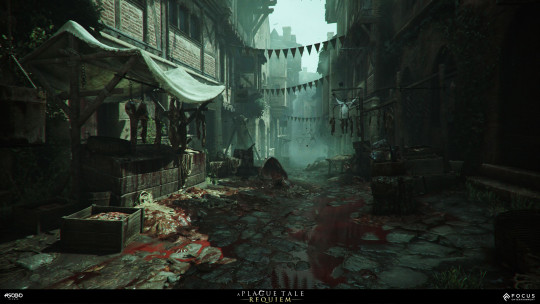
As I dive deeper into the development of Timeless Epoch, I’ve constantly sought out artists and games whose work captures the kind of mood and texture I want to bring into my world. One standout inspiration—especially for the medieval modular asset kit I’m working on—has been the stunning environment design work of Julien Hemmerlé on A Plague Tale: Requiem.
A Masterclass in Medieval Atmosphere

Julien’s environments strike a beautiful balance between historical accuracy and artistic emotion. The scenes feel lived in, aged, and weighed down by history. It’s not just about putting bricks and stones in place—it’s about using texture, lighting, and composition to convey sorrow, desperation, or quiet resilience.
For someone working on a project where world-building and lore are key components, this type of environmental storytelling is massively influential. My own goal is to create a world where architecture doesn’t just serve function, but carries emotional tone—and Julien’s work has shown me exactly how powerful that can be.
Textures That Speak

One of the biggest takeaways from his work is how the materials do so much of the storytelling. Whether it’s the weathered stones, moss-covered rooftops, or splintering wood, there’s a tactile quality that feels incredibly real.
This has inspired me to push further in my own texturing efforts—particularly in Substance Painter and Designer. I want the player to feel the texture of a wall or the chill of a damp stone passage just by looking at it.
Atmosphere Over Action

What drew me most to Julien Hemmerlé’s environments isn’t just their visual fidelity—it’s their sense of silence. Many of the environments in A Plague Tale: Requiem feel almost frozen in time. There’s a melancholic beauty in how ruins, villages, and cathedrals sit quietly amidst nature reclaiming them. And that’s something I want to capture in Timeless Epoch—a world that holds echoes of different eras, bound together by the aesthetics of decay, memory, and resilience.
Influence on Timeless Epoch
This influence is already shaping how I approach my medieval kit. I’m not just looking to model arches or stone tiles—I’m studying the subtleties: broken roof beams, uneven tiling, grime buildup where rain always hits. Even in the layout and spacing of assets, Julien’s work has made me appreciate the art of natural imperfection.
Timeless Epoch is meant to feel both fantastical and grounded, and Julien Hemmerlé’s artistry is one of the benchmarks I’m using to reach that balance.
0 notes
Text
Development Blog: Timeless Epoch
Blog #17 – Finishing the Designer First Steps Series
Diving Deeper into Substance Designer
youtube
After completing the “Designer First Steps” tutorial series, I’ve had the chance to put my knowledge into practice—and I have to say, the experience was both challenging and incredibly rewarding.
The tutorial series walked me through the creation of a highly detailed fabric material, complete with rich ornaments and layered surface detail. It was the perfect introduction to the program’s strengths and its steep learning curve.
What I Learned

Here are the key takeaways from this phase of learning:
Detailed Fabric Creation: I successfully created an ornate cloth material from scratch, learning how to build patterns, apply height and normal information, and tweak parameters to my liking.

Customizability: Substance Designer’s node system offers unmatched control—perfect for the kind of adjustable, reusable textures I want to build for my modular kits.

Intuitive Once You Dive In: Although intimidating at first, Designer quickly became intuitive. It’s a tool that rewards experimentation and problem-solving—two skills I already bring from my programming background.

Perfect for Medieval Wall Textures: This tool will be especially valuable as I begin creating custom wall textures and material sets for the medieval-inspired modular kit in Timeless Epoch.
Moving Forward
This foundation in Designer opens up a whole new level of control in my project. With texturing skills now growing in both Painter and Designer, I feel much more confident in pushing toward the quality I see in my inspirational sources.
0 notes
Text
Development Blog: Timeless Epoch
Blog #16 – Learning Adobe Substance Designer
Why Substance Designer?
youtube
As I continue to refine my skills as a 3D environment artist, I’ve realized that understanding how to create materials from scratch is absolutely essential. That’s why I’m now diving into Adobe Substance 3D Designer—a tool that many top-tier game studios rely on to build their material libraries.
Here’s why I’m prioritizing it:

Procedural Power: Substance Designer offers a node-based, programming-style approach to creating textures. That fits perfectly with my background in computer science and my passion for algorithmic processes, like those used in PCG systems.
Custom Materials: It allows artists to build entirely unique, customizable materials—which means I can start building stylized or realistic surfaces tailored specifically to the themes of Timeless Epoch.
Style Control: Whether I want medieval stone walls or industrial metal panels, Designer puts full control in my hands, letting me tweak fine details in ornamentation, wear, roughness, and more.
A Key to Artistic Freedom: Instead of relying on pre-made materials or marketplace content, I’ll be able to craft a bespoke material library—a long-term investment in my versatility as a 3D artist.
The Learning Plan
To get started, I’m currently following the “Designer First Steps” series on Adobe’s official YouTube channel. The goal is to understand the basics of the software and work toward creating a cloth material from scratch.
By learning how to manipulate nodes, create tiling textures, and apply ornamentation, I’ll begin the process of building the kinds of materials I’ll need for Timeless Epoch—particularly those used in modular architecture kits.
Resources:
Adobe Substance 3D (2024). Adobe Substance 3D Designer for Beginners | Course Overview | Adobe Substance 3D. [online] YouTube. Available at: https://www.youtube.com/watch?v=At3FoFcuN6k&list=PLB0wXHrWAmCxBw92VSRjqsbqYXgkF8puC
ArtStation. (2025). A Plague Tale: Requiem - Chapter III, Olivier Cannone. [online] Available at: https://www.artstation.com/artwork/4XKW5Y [Accessed 23 Apr. 2025].
ArtStation. (2025). A Plague Tale: Requiem – Concept arts part 2, Tom Hisbergue. [online] Available at: https://www.artstation.com/artwork/140zlZ [Accessed 23 Apr. 2025].
ArtStation. (2025). Frostpunk 2: Environment Concept Arts, ZooWe (Tsu-Wei) Chen. [online] Available at: https://www.artstation.com/artwork/3EeBgo [Accessed 23 Apr. 2025].
ArtStation. (2025). Isaac Oster. [online] Available at: https://www.artstation.com/isaacoster [Accessed 23 Apr. 2025].
ArtStation. (2025). Jef Simons. [online] Available at: https://www.artstation.com/jef_simons [Accessed 23 Apr. 2025].
ArtStation. (2025). joannie leblanc. [online] Available at: https://www.artstation.com/joannie [Accessed 23 Apr. 2025].
ArtStation. (2025). Michael Chae. [online] Available at: https://www.artstation.com/michaelchae [Accessed 23 Apr. 2025].
Artstation.com. (2025). Page Restricted. [online] Available at: https://www.artstation.com/tonch-la-gonch [Accessed 23 Apr. 2025].
ArtStation. (2025). Shinta Lyu. [online] Available at: https://www.artstation.com/kiritsugu [Accessed 23 Apr. 2025].
ArtStation. (2025). Tanguy Talbert. [online] Available at: https://www.artstation.com/gaxxx [Accessed 23 Apr. 2025].
ArtStation. (2025). TRACE studio. [online] Available at: https://www.artstation.com/trace_studio [Accessed 23 Apr. 2025].
ArtStation. (2025). V Rising - Environment Props, Linn Wilhelmsson. [online] Available at: https://www.artstation.com/artwork/rlDqVO [Accessed 23 Apr. 2025].
baldursgate3.game. (n.d.). Baldur’s Gate 3. [online] Available at: https://baldursgate3.game
Epic Games (2024). Procedural Content Generation Overview | Unreal Engine 5.5 Documentation | Epic Developer Community. [online] Epic Games Developer. Available at: https://dev.epicgames.com/documentation/en-us/unreal-engine/procedural-content-generation-overview
OpenAI (2025). ChatGPT. [online] chatgpt.com. Available at: https://chatgpt.com.
Procedural Minds - YouTube. Creating Procedural Content. [online] Available at: https://www.youtube.com/@Procedural_Minds
Stuart, K. (2022). A beginner’s guide to Elden Ring: what it is and why you should play it. The Guardian. [online] 2 Mar. Available at: https://www.theguardian.com/games/2022/mar/02/elden-ring-beginners-guide-open-world-adventure
Substance Painter 2021. Getting Started - Course Introduction. [online] Available at: https://www.youtube.com/watch?v=-ZbmRsOnApk&list=PLB0wXHrWAmCwnqWfKdGEmbtSKN2EzvLrY
UNF Games (2024). Creating a village using Procedural Generation PCG in Unreal Engine 5 - Beginner Tutorial. [online] YouTube. Available at: https://www.youtube.com/watch?v=E5tsS-5sYYo [Accessed 23 Dec. Mar]
www.focus-entmt.com. (n.d.). A Plague Tale: Requiem - Focus Entertainment. [online] Available at: https://www.focus-entmt.com/en/games/a-plague-tale-requiem
War:, T. (2022). Total War: WARHAMMER III - Home. [online] Totalwar.com. Available at: https://warhammer3.totalwar.com [Accessed 23 Apr. 2025].
0 notes
Text
Development Blog: Timeless Epoch
Blog #15 – Finishing the Substance Painter Tutorials
Wrapping Up the Tutorial Series
youtube
As part of my commitment to improving my texturing skills, I recently completed the “Substance Painter 2021 Getting Started” tutorial series on YouTube. The course walked me through the full process of texturing a sci-fi robot model—starting from the basics and gradually layering in more advanced features.
While the course content was structured for beginners, it provided a wealth of practical techniques that directly improved my day-to-day workflow in Adobe Substance 3D Painter.
What I Learned




Over the course of the tutorials, I picked up numerous tips and tricks that I’ve already begun to integrate into my Timeless Epoch workflow:
Quick Texture Application: How to apply and fine-tune materials rapidly while maintaining control over detail and variation.
Vertex Painting Use Cases: Understanding how vertex painting can be used in combination with masks to introduce unique surface wear or color variations.
Decals System: Gained a new appreciation for the decal feature in Painter, which allows for non-destructive placement of logos, damage, text, and dirt.
Normal Map Exploration: I took a deeper dive into how normal maps affect surface detail and how they can be used to fake depth and complexity without increasing geometry.
These aren’t just flashy features—they’re workflow enhancers that make a real difference when working with modular assets and large environment kits.
My Own Spin: Dark Angels Repaint

Once the course was complete, I retextured the robot from scratch, this time applying my own creative spin using the Dark Angels color scheme from Warhammer 40K.
The result was a satisfying exercise in artistic direction, as I explored how to balance grim, battle-worn surfaces with a cleaner, ceremonial aesthetic. It helped reinforce everything I’d just learned, but also challenged me to push further with custom mask creation, smart material blending, and stylized detailing.
A Bioshock Detour That Didn’t Happen (Yet)

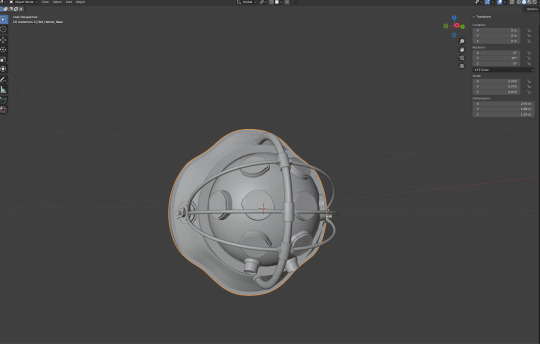

Originally, I had planned to texture a Bioshock-style helmet that I previously modeled as an additional exercise. But after some thought, I’ve decided to keep it as a separate project—one that I can polish and present independently, rather than squeezing it into the Timeless Epoch workflow.
This decision helps keep my current focus sharp and dedicated to the needs of this project, especially with modular asset creation and PCG design just around the corner.
What’s Next: Adobe Substance 3D Designer
With this part of my learning complete, I’m now setting my sights on Adobe Substance 3D Designer. The ability to create materials from scratch is an essential skill for any environment artist—and for the kind of architectural detail and stylization I want to achieve, procedural texture creation will play a major role.
This next step will complement my work in Painter and help me push even closer toward the visual targets I’ve set for Timeless Epoch.
Resources:
Adobe Substance 3D (2024). Adobe Substance 3D Designer for Beginners | Course Overview | Adobe Substance 3D. [online] YouTube. Available at: https://www.youtube.com/watch?v=At3FoFcuN6k&list=PLB0wXHrWAmCxBw92VSRjqsbqYXgkF8puC
ArtStation. (2025). A Plague Tale: Requiem - Chapter III, Olivier Cannone. [online] Available at: https://www.artstation.com/artwork/4XKW5Y [Accessed 23 Apr. 2025].
ArtStation. (2025). A Plague Tale: Requiem – Concept arts part 2, Tom Hisbergue. [online] Available at: https://www.artstation.com/artwork/140zlZ [Accessed 23 Apr. 2025].
ArtStation. (2025). Frostpunk 2: Environment Concept Arts, ZooWe (Tsu-Wei) Chen. [online] Available at: https://www.artstation.com/artwork/3EeBgo [Accessed 23 Apr. 2025].
ArtStation. (2025). Isaac Oster. [online] Available at: https://www.artstation.com/isaacoster [Accessed 23 Apr. 2025].
ArtStation. (2025). Jef Simons. [online] Available at: https://www.artstation.com/jef_simons [Accessed 23 Apr. 2025].
ArtStation. (2025). joannie leblanc. [online] Available at: https://www.artstation.com/joannie [Accessed 23 Apr. 2025].
ArtStation. (2025). Michael Chae. [online] Available at: https://www.artstation.com/michaelchae [Accessed 23 Apr. 2025].
Artstation.com. (2025). Page Restricted. [online] Available at: https://www.artstation.com/tonch-la-gonch [Accessed 23 Apr. 2025].
ArtStation. (2025). Shinta Lyu. [online] Available at: https://www.artstation.com/kiritsugu [Accessed 23 Apr. 2025].
ArtStation. (2025). Tanguy Talbert. [online] Available at: https://www.artstation.com/gaxxx [Accessed 23 Apr. 2025].
ArtStation. (2025). TRACE studio. [online] Available at: https://www.artstation.com/trace_studio [Accessed 23 Apr. 2025].
ArtStation. (2025). V Rising - Environment Props, Linn Wilhelmsson. [online] Available at: https://www.artstation.com/artwork/rlDqVO [Accessed 23 Apr. 2025].
baldursgate3.game. (n.d.). Baldur’s Gate 3. [online] Available at: https://baldursgate3.game
Epic Games (2024). Procedural Content Generation Overview | Unreal Engine 5.5 Documentation | Epic Developer Community. [online] Epic Games Developer. Available at: https://dev.epicgames.com/documentation/en-us/unreal-engine/procedural-content-generation-overview
OpenAI (2025). ChatGPT. [online] chatgpt.com. Available at: https://chatgpt.com.
Procedural Minds - YouTube. Creating Procedural Content. [online] Available at: https://www.youtube.com/@Procedural_Minds
Stuart, K. (2022). A beginner’s guide to Elden Ring: what it is and why you should play it. The Guardian. [online] 2 Mar. Available at: https://www.theguardian.com/games/2022/mar/02/elden-ring-beginners-guide-open-world-adventure
Substance Painter 2021. Getting Started - Course Introduction. [online] Available at: https://www.youtube.com/watch?v=-ZbmRsOnApk&list=PLB0wXHrWAmCwnqWfKdGEmbtSKN2EzvLrY
UNF Games (2024). Creating a village using Procedural Generation PCG in Unreal Engine 5 - Beginner Tutorial. [online] YouTube. Available at: https://www.youtube.com/watch?v=E5tsS-5sYYo [Accessed 23 Dec. Mar]
www.focus-entmt.com. (n.d.). A Plague Tale: Requiem - Focus Entertainment. [online] Available at: https://www.focus-entmt.com/en/games/a-plague-tale-requiem
War:, T. (2022). Total War: WARHAMMER III - Home. [online] Totalwar.com. Available at: https://warhammer3.totalwar.com [Accessed 23 Apr. 2025].
0 notes
Text
Development Blog: Timeless Epoch
Blog #14 – Improving My Texturing Skills in Substance 3D Painter
Identifying a Weak Point
As I progress deeper into the development of Timeless Epoch, one critical area I’ve marked for improvement is texturing. While my past work has shown competence in asset creation and modular design, I’ve often felt that the final visual impact could be elevated further—especially when compared to the stunning material work seen in games like Baldur’s Gate 3 or Space Marine 2.
To bring my assets in line with those benchmarks, I need to push my understanding of Substance 3D Painter much further. This includes not just knowing how to texture efficiently but learning the visual nuances that make a material feel convincing.
Learning from the Source
youtube
To build a solid foundation, I’ve started following the official Adobe Substance 3D YouTube tutorials. These offer a clear, structured approach to the fundamentals—breaking down workflows, layer management, mask usage, smart materials, and more.
While the material in these tutorials may start simple, they have been invaluable in showing how to:
Build reusable material setups
Think about roughness, height, and metallic maps with more intention
Work faster using anchor points and generators
Layer procedural effects with painted ones for a richer result
They’re not just showing how to texture—they’re showing how to do it well and efficiently, which is essential for game-ready asset development.
My Variation Process

After completing each tutorial, I take the original workflow and create my own version of the asset. This has become a key part of my learning strategy—translating what I’ve just seen into something personal.
For instance, if the tutorial shows how to texture a sci-fi panel, I’ll adapt the workflow to texture something more grounded in my world—like a steampunk-style door or a weathered stone arch. These adaptations allow me to experiment while staying within the structure provided by the tutorial.
This exercise has already highlighted a few ways I can improve:
Finding a better balance between handcrafted detail and procedural overlays
Avoiding over-reliance on smart materials
Customizing grunge and wear to reflect environmental storytelling
Building Toward My Visual Goals
Improving my texturing workflow is not just a side exercise—it’s essential to achieving the visual standards of my inspirations. Whether I’m working on cracked stone walls or oily industrial girders, the success of these assets will depend heavily on my ability to communicate form, material, and age through texture.
Texturing is also one of the key components that separate a good modular kit from a great one. It provides the final pass that pulls everything together, and I’m determined to level up this skill to match the quality I’m striving for in Timeless Epoch.
Resources:
Adobe Substance 3D (2024). Adobe Substance 3D Designer for Beginners | Course Overview | Adobe Substance 3D. [online] YouTube. Available at: https://www.youtube.com/watch?v=At3FoFcuN6k&list=PLB0wXHrWAmCxBw92VSRjqsbqYXgkF8puC
ArtStation. (2025). A Plague Tale: Requiem - Chapter III, Olivier Cannone. [online] Available at: https://www.artstation.com/artwork/4XKW5Y [Accessed 23 Apr. 2025].
ArtStation. (2025). A Plague Tale: Requiem – Concept arts part 2, Tom Hisbergue. [online] Available at: https://www.artstation.com/artwork/140zlZ [Accessed 23 Apr. 2025].
ArtStation. (2025). Frostpunk 2: Environment Concept Arts, ZooWe (Tsu-Wei) Chen. [online] Available at: https://www.artstation.com/artwork/3EeBgo [Accessed 23 Apr. 2025].
ArtStation. (2025). Isaac Oster. [online] Available at: https://www.artstation.com/isaacoster [Accessed 23 Apr. 2025].
ArtStation. (2025). Jef Simons. [online] Available at: https://www.artstation.com/jef_simons [Accessed 23 Apr. 2025].
ArtStation. (2025). joannie leblanc. [online] Available at: https://www.artstation.com/joannie [Accessed 23 Apr. 2025].
ArtStation. (2025). Michael Chae. [online] Available at: https://www.artstation.com/michaelchae [Accessed 23 Apr. 2025].
Artstation.com. (2025). Page Restricted. [online] Available at: https://www.artstation.com/tonch-la-gonch [Accessed 23 Apr. 2025].
ArtStation. (2025). Shinta Lyu. [online] Available at: https://www.artstation.com/kiritsugu [Accessed 23 Apr. 2025].
ArtStation. (2025). Tanguy Talbert. [online] Available at: https://www.artstation.com/gaxxx [Accessed 23 Apr. 2025].
ArtStation. (2025). TRACE studio. [online] Available at: https://www.artstation.com/trace_studio [Accessed 23 Apr. 2025].
ArtStation. (2025). V Rising - Environment Props, Linn Wilhelmsson. [online] Available at: https://www.artstation.com/artwork/rlDqVO [Accessed 23 Apr. 2025].
baldursgate3.game. (n.d.). Baldur’s Gate 3. [online] Available at: https://baldursgate3.game
Epic Games (2024). Procedural Content Generation Overview | Unreal Engine 5.5 Documentation | Epic Developer Community. [online] Epic Games Developer. Available at: https://dev.epicgames.com/documentation/en-us/unreal-engine/procedural-content-generation-overview
OpenAI (2025). ChatGPT. [online] chatgpt.com. Available at: https://chatgpt.com.
Procedural Minds - YouTube. Creating Procedural Content. [online] Available at: https://www.youtube.com/@Procedural_Minds
Stuart, K. (2022). A beginner’s guide to Elden Ring: what it is and why you should play it. The Guardian. [online] 2 Mar. Available at: https://www.theguardian.com/games/2022/mar/02/elden-ring-beginners-guide-open-world-adventure
Substance Painter 2021. Getting Started - Course Introduction. [online] Available at: https://www.youtube.com/watch?v=-ZbmRsOnApk&list=PLB0wXHrWAmCwnqWfKdGEmbtSKN2EzvLrY
UNF Games (2024). Creating a village using Procedural Generation PCG in Unreal Engine 5 - Beginner Tutorial. [online] YouTube. Available at: https://www.youtube.com/watch?v=E5tsS-5sYYo [Accessed 23 Dec. Mar]
www.focus-entmt.com. (n.d.). A Plague Tale: Requiem - Focus Entertainment. [online] Available at: https://www.focus-entmt.com/en/games/a-plague-tale-requiem
War:, T. (2022). Total War: WARHAMMER III - Home. [online] Totalwar.com. Available at: https://warhammer3.totalwar.com [Accessed 23 Apr. 2025].
0 notes
Text
Development Blog: Timeless Epoch
Blog #13 – Inspirations for the Modular Assets and Aesthetic Direction
A World Built on Contrast

The visual ambition of Timeless Epoch has always been to depict a world shaped by opposing forces—cultures, timelines, and technologies colliding into a single, cohesive narrative space. To communicate that contrast through modular design, I’ve decided to develop two distinct architectural kits:
A medieval-inspired modular kit, grounded in stone, timber, and grounded elegance.
An industrial/steampunk-inspired modular kit, defined by metal, soot, complexity, and harsh silhouettes.
Each of these kits will draw directly from a curated set of games that exemplify the moods, motifs, and materials I want to reflect in my own work.
Medieval Influence:
Baldur’s Gate 3 and A Plague Tale: Requiem
For the medieval kit, my primary references come from two masterful pieces of game art direction:
Baldur’s Gate 3 – The Temple of Shar, the Underdark ruins, and even the countryside structures display an expert use of modularity without sacrificing handcrafted detail. The ability of these assets to balance fantasy with architectural believability makes them ideal references. I’m especially drawn to the subtle trim usage, use of ornate but practical materials, and believable weathering.

A Plague Tale: Requiem – While it leans more historical than high fantasy, its environmental storytelling is unmatched. The chipped plaster, aged brick, and structural fragility of its world are perfect for developing modular elements that feel lived-in and tragic. This game inspires my focus on material layering—where wood, stone, and grime exist in harmony.

These references will help inform a kit that feels ancient, weathered, and mythic in tone. Functionally, I’ll be looking to recreate key modular components like arches, columns, roof modules, windows, and walls, all made to snap together and still tell stories of a forgotten era.
Industrial/Steampunk Influence:
Space Marine 2 and Frostpunk 2
For the second kit, my goal is to contrast the elegance of stonework with a colder, industrial aesthetic inspired by these games:
Space Marine 2 – This universe is the visual definition of grimdark—massive metallic structures, heavy paneling, rivets, and gothic silhouettes. I’ll be pulling inspiration from its monolithic design language: overengineered doors, reinforced platforms, and imposing vertical elements. It's a fusion of industry and war, which suits the "civilization on the brink" theme of Timeless Epoch.

Frostpunk 2 – While different in tone, Frostpunk’s use of vertical structures, twisted pipes, and functional design is deeply inspiring. There’s a sense of desperation and innovation in its architecture. I'm particularly interested in how buildings feel pieced together over time—an aspect I’d like to reflect using interchangeable parts and visual storytelling through asset decay.
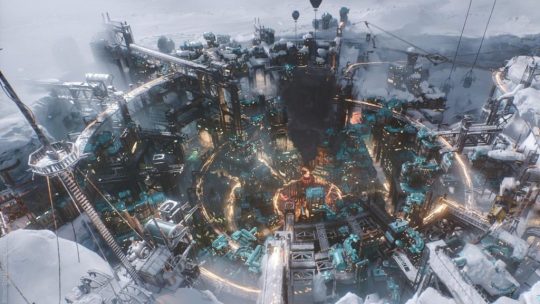
This kit will focus on metallic surfaces, modular pipe systems, rusted and scorched elements, and unique silhouettes that make the architecture feel both advanced and deteriorating.
Shaping the Epoch: A Converging Aesthetic
By juxtaposing the medieval and industrial kits, the world of Timeless Epoch begins to take form: a place where time has fractured and opposing aesthetics coexist. Each kit won’t just serve different visual zones—they will reflect different factions, ideologies, and histories within the lore of the world.
And through modularity, these kits can be extended, reimagined, and recombined to tell as many stories as needed.
Resources:
Adobe Substance 3D (2024). Adobe Substance 3D Designer for Beginners | Course Overview | Adobe Substance 3D. [online] YouTube. Available at: https://www.youtube.com/watch?v=At3FoFcuN6k&list=PLB0wXHrWAmCxBw92VSRjqsbqYXgkF8puC
ArtStation. (2025). A Plague Tale: Requiem - Chapter III, Olivier Cannone. [online] Available at: https://www.artstation.com/artwork/4XKW5Y [Accessed 23 Apr. 2025].
ArtStation. (2025). A Plague Tale: Requiem – Concept arts part 2, Tom Hisbergue. [online] Available at: https://www.artstation.com/artwork/140zlZ [Accessed 23 Apr. 2025].
ArtStation. (2025). Frostpunk 2: Environment Concept Arts, ZooWe (Tsu-Wei) Chen. [online] Available at: https://www.artstation.com/artwork/3EeBgo [Accessed 23 Apr. 2025].
ArtStation. (2025). Isaac Oster. [online] Available at: https://www.artstation.com/isaacoster [Accessed 23 Apr. 2025].
ArtStation. (2025). Jef Simons. [online] Available at: https://www.artstation.com/jef_simons [Accessed 23 Apr. 2025].
ArtStation. (2025). joannie leblanc. [online] Available at: https://www.artstation.com/joannie [Accessed 23 Apr. 2025].
ArtStation. (2025). Michael Chae. [online] Available at: https://www.artstation.com/michaelchae [Accessed 23 Apr. 2025].
Artstation.com. (2025). Page Restricted. [online] Available at: https://www.artstation.com/tonch-la-gonch [Accessed 23 Apr. 2025].
ArtStation. (2025). Shinta Lyu. [online] Available at: https://www.artstation.com/kiritsugu [Accessed 23 Apr. 2025].
ArtStation. (2025). Tanguy Talbert. [online] Available at: https://www.artstation.com/gaxxx [Accessed 23 Apr. 2025].
ArtStation. (2025). TRACE studio. [online] Available at: https://www.artstation.com/trace_studio [Accessed 23 Apr. 2025].
ArtStation. (2025). V Rising - Environment Props, Linn Wilhelmsson. [online] Available at: https://www.artstation.com/artwork/rlDqVO [Accessed 23 Apr. 2025].
baldursgate3.game. (n.d.). Baldur’s Gate 3. [online] Available at: https://baldursgate3.game
Epic Games (2024). Procedural Content Generation Overview | Unreal Engine 5.5 Documentation | Epic Developer Community. [online] Epic Games Developer. Available at: https://dev.epicgames.com/documentation/en-us/unreal-engine/procedural-content-generation-overview
OpenAI (2025). ChatGPT. [online] chatgpt.com. Available at: https://chatgpt.com.
Procedural Minds - YouTube. Creating Procedural Content. [online] Available at: https://www.youtube.com/@Procedural_Minds
Stuart, K. (2022). A beginner’s guide to Elden Ring: what it is and why you should play it. The Guardian. [online] 2 Mar. Available at: https://www.theguardian.com/games/2022/mar/02/elden-ring-beginners-guide-open-world-adventure
Substance Painter 2021. Getting Started - Course Introduction. [online] Available at: https://www.youtube.com/watch?v=-ZbmRsOnApk&list=PLB0wXHrWAmCwnqWfKdGEmbtSKN2EzvLrY
UNF Games (2024). Creating a village using Procedural Generation PCG in Unreal Engine 5 - Beginner Tutorial. [online] YouTube. Available at: https://www.youtube.com/watch?v=E5tsS-5sYYo [Accessed 23 Dec. Mar]
www.focus-entmt.com. (n.d.). A Plague Tale: Requiem - Focus Entertainment. [online] Available at: https://www.focus-entmt.com/en/games/a-plague-tale-requiem
War:, T. (2022). Total War: WARHAMMER III - Home. [online] Totalwar.com. Available at: https://warhammer3.totalwar.com [Accessed 23 Apr. 2025].
1 note
·
View note
Text
Development Blog: Timeless Epoch
Blog #12 – Modular Asset Kits
The Role of Modular Kits in 3D Art

Modular kits are one of the most essential tools in a 3D artist’s arsenal—especially for environment art. They allow for the creation of flexible, reusable, and optimized pieces that can be arranged in countless combinations to form coherent environments. Games like Baldur’s Gate 3, The Witcher 3, and Frostpunk rely heavily on modular construction to deliver massive, detailed worlds without sacrificing workflow efficiency or visual quality.
For Timeless Epoch, the modular kits will serve as the visual backbone of the world-building process.
Giving Modular Assets the Focus They Deserve
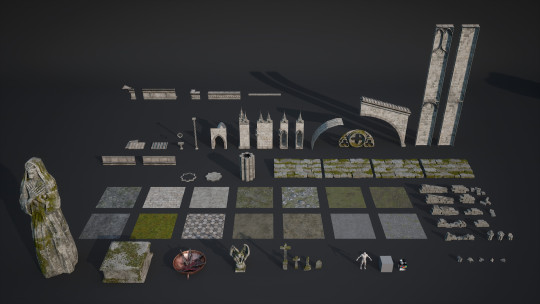

While the project incorporates a procedural system, the visual quality of the final environments will be entirely dependent on the modular assets themselves. For this reason, I’ve decided to give the modular kit creation extra attention throughout development. These kits will be the core building blocks of the project, and my aim is to treat them not just as components, but as fully realized, high-quality assets capable of standing on their own.
Areas of Improvement: Texturing & Trim Sheet Design
To raise the quality of my modular kits, I’ve identified two key areas for personal growth:
Texturing: Although I’m comfortable with the basics, I want to elevate the realism and visual storytelling of each asset through more thoughtful material creation and detail.
Trim Sheet Design: I plan to push myself in designing efficient, reusable trim sheets that allow for both consistency and detail across multiple assets without redundancy.
Improving these areas will not only enhance the final visuals but also deepen my understanding of professional workflows used in AAA studios.
Tools and Workflow: Substance Suite
To achieve the visual fidelity I’m aiming for, I’ll be working extensively in:
Substance 3D Painter – for hand-painted and smart-material-driven surface details.
Substance 3D Designer – for creating high-quality, custom materials and trim sheets from scratch.
These tools will allow me to iterate quickly while ensuring the materials remain modular, scalable, and artistically controlled.
Project Scope: Two Distinct Modular Kits
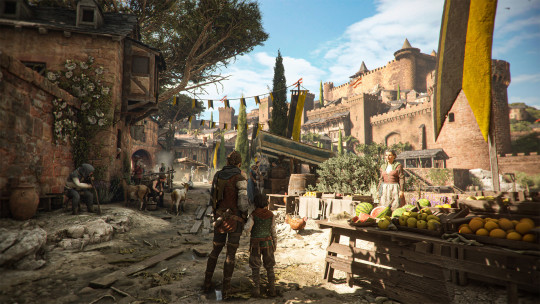
My goal for this project is to produce at least two distinct architectural modular kits, each with its own identity and aesthetic direction, yet compatible within the same universe. This will reflect the “timeless” theme of the project—structures that could belong to different eras or civilizations, yet co-exist logically in the same world.
Each piece will be crafted with care, referencing my core artistic inspirations, and will be designed to integrate seamlessly with the PCG system I’m building in parallel.
0 notes
Text
Development Blog: Timeless Epoch
Blog #11 – PCG: Building Toward Roof Detection

Iterating on Foundations
After establishing a basic grid system and learning to manipulate points within a PCG graph, the next goal was to push toward something functional for the core of Timeless Epoch—enclosed area detection and rooftop generation.
Interior Boundaries and Enclosure Logic


Following Procedural Minds' advanced PCG tutorials, I’ve started developing logic to determine whether a group of modular walls form an enclosed space. This is the heart of the system I want to create, much like how V Rising automatically places rooftops over player-made bases.
The enclosure detection is still a work-in-progress, but I’ve begun experimenting with tags and spatial relationships that could serve as markers for closed loops or boundary lines.
Toward Roof Generation

With enclosure logic slowly taking shape, I’m prototyping how roofs can be procedurally generated atop these identified spaces. Using placeholder roof meshes for now, the idea is to test out different bounding volumes and trigger conditions—once all boundary pieces are detected, spawn a matching roof piece.
Reflection
At this point, the PCG system feels less like an experimental add-on and more like a powerful tool that could genuinely support large-scale environment creation. It’s clear that learning how to build these systems modularly and efficiently will shape the rest of this project—and future ones too.
0 notes
Text
Development Blog: Timeless Epoch
Blog #10 – PCG: Laying the Groundwork
Starting Simple – Following Procedural Minds
youtube
I began this phase of development by following the YouTube tutorials from Procedural Minds, which provide a solid foundation for understanding how Unreal Engine’s Procedural Content Generation tools work. My goal was to get familiar with the basic building blocks of PCG graphs, point sampling, and spawning logic using modular pieces.
Establishing Grid and Points

The first implementation was setting up a basic PCG graph that generates a grid of points across a defined area. These points will later be used to place modular pieces like floor tiles, walls, or support pillars. The system now recognizes surface areas, scatters points, and prepares them for geometry spawning.
Early Visual Feedback
Using basic placeholder meshes, I tested point generation to ensure the PCG system properly interprets scale, distance, and orientation. Even at this early stage, seeing content being automatically populated based on a set of rules was incredibly satisfying and aligned with the scalable vision of Timeless Epoch.
Challenges

My main challenge so far was tweaking parameters to maintain precision in alignment—something that’s critical for a modular architecture setup. Minor offsets in rotation or translation can create visual breaks, which I’ll have to watch closely going forward.
0 notes
Text
Development Blog: Timeless Epoch
Blog #9 – Inspirational Breakdown: Isaac Oster’s Procedural Cell Tower

As I continue to develop the backbone of Timeless Epoch, I find it important not only to study beautiful environments and fantastical worlds, but to also look toward precise, technically sound projects that showcase strong modular logic and procedural construction. One such project that stood out during my research phase was Isaac Oster’s “Procedural Cell Tower”, a technical showcase on ArtStation that embodies the kind of rule-based design thinking essential for any environment artist diving into PCG systems.
While a modern cell tower may seem a world apart from the mythic ruins and strange architectures of Urubis Exilium, the systems and methodology behind Oster’s work have proven to be deeply relevant to how I think about modularity and procedural content creation.
Breaking Down the Work

Isaac Oster’s Procedural Cell Tower project demonstrates a system-driven approach to constructing vertical structures that rely heavily on:
Repeated modules, stacked according to a procedural rule set

Clearly defined pivot points and attachment logic
The use of interchangeable elements to allow for visual variety without sacrificing structure
A strong technical-art mindset that puts as much weight on workflow efficiency as it does on aesthetics

What made his project so compelling was the modular clarity in the design. Each element—from antenna arms to support rings and tower segments—was created as an interchangeable piece, with a clear role in the system. This made it easy to understand how a procedural approach could not only construct the tower from the ground up but also adjust its visual tone depending on which modules were included.
What I Took Away From It
Even though my project is rooted in high-fantasy aesthetics and ancient-world architecture, the logic behind Oster’s design gave me valuable insight into the kinds of rules and parameters I’ll need to define for my PCG system in Timeless Epoch.
Key lessons I took from his work:
Procedural clarity comes from modular discipline: Every module in his tower serves a function. This reinforces that for procedural systems to work well, the modular kits must be designed with technical precision.
Vertical stacking logic: The cell tower structure exemplifies controlled verticality, something I can adapt to structures like towers, minarets, or chimneys in Urubis Exilium.
Controlled randomness: Even though procedural generation can introduce variety, Oster’s work shows that this variety must be grounded in carefully constrained systems. Randomness without logic breaks immersion.
This mindset is directly influencing how I’ll approach building sets for different architectural factions in the world—where each module will carry a clear identity but follow structural logic for clean, procedural placement.
How It Connects to Timeless Epoch
In Timeless Epoch, I aim to create a city that evolves out of exile—built by people who bring their own blueprints, ideologies, and construction methods. The result will not be symmetrical or uniform. Instead, it will be structured chaos—with the PCG system responsible for stitching together disparate modules into coherent architecture.
Here’s how Oster’s methodology feeds into that:
His tower structure = My factional verticals. I’m adapting his stacking method for watchtowers, pylons, and spires, each built differently depending on the cultural module set.
His logic-driven assembly = My procedural rules. I want my PCG system to detect placement patterns, such as vertical progression or enclosed nodes, and respond accordingly.
His interchangeability = My architectural diversity. Swapping in a few modules should result in a vastly different architectural tone—just like swapping materials and methods between cultures in Urubis.
Final Thoughts
Isaac Oster’s work may not involve medieval towers or fantasy environments, but it perfectly illustrates what clean modular thinking looks like when integrated into procedural workflows. It’s a great reminder that before any PCG system can produce beauty, it must be built upon a foundation of technical clarity and system logic.
As I now begin prototyping my modular asset kits, Oster’s principles will be top of mind. Each piece I design must carry within it the logic for how it connects, transforms, and scales across a procedurally generated world.
0 notes
Text
Development Blog: Timeless Epoch
Blog #8: Supplementary Entry – Inspiration for the PCG System

When I began laying the groundwork for Timeless Epoch, it became immediately clear that the city of Urubis Exilium—a place shaped by exile, diversity, and adaptive survival—needed a design system just as fluid and adaptive as the narrative that drives it. The deeper I explored the lore, the more I realized that Procedural Content Generation (PCG) wasn’t just a convenient tool—it was a thematic necessity.
The following inspirations, both technical and artistic, played a key role in shaping my vision for the PCG system I’m building for this project.
1. V Rising – The Roof-Building Mechanic
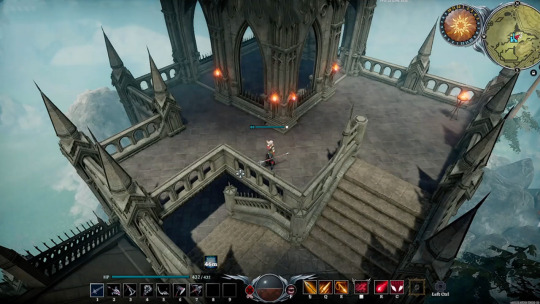
One of the earliest and most direct inspirations came from Stunlock Studios’ V Rising (2022). In its base-building system, when a player uses modular wall pieces to form an enclosed structure, the game automatically generates a roof to seal the space. This mechanic is deceptively simple, but incredibly elegant in how it maintains immersion and gives structure to gameplay.
It aligns perfectly with the goals of Timeless Epoch:
It offers a rule-based system for architecture that makes sense visually and logically.
It responds to player agency, adapting to layout rather than dictating it.
It maintains consistency across modular pieces while still allowing creative freedom.
My PCG system will attempt to replicate this mechanic in Unreal Engine—detecting enclosed modular spaces and auto-generating a rooftop structure. But beyond replication, I also hope to extend its logic to include different roof types, architectural styles, and cultural identities, depending on the modules used. In this way, the mechanic becomes not just functional, but expressive—each rooftop reflecting the origin of its builders.
2. Tanguy Talbert – Modular PCG Systems in Unreal Engine
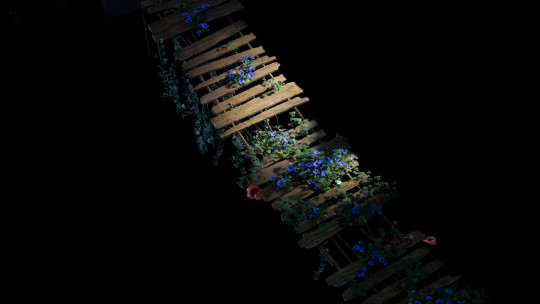
Tanguy Talbert’s work has been a major technical and artistic reference point for this project. His PCG system breakdowns on ArtStation, particularly his procedural bridge setups and modular kits in Unreal, demonstrate how powerful data-driven design workflows can be when paired with a clean artistic vision.
What stood out most was:
The ability to create repeatable logic across assets
The intelligent layering of structural complexity, like props, supports, and details, atop core architecture
The balance between manual artistry and procedural efficiency
Talbert’s approach showed me that PCG doesn’t have to be cold or purely functional—it can enhance creativity. His system isn’t about removing the artist from the process, but about empowering them to focus on the moments that matter.
In Timeless Epoch, I aim to take a similar stance: build a system that augments the worldbuilder, allowing me to place the bones of Urubis Exilium quickly, while focusing more of my time on texture fidelity, lighting, and narrative placement.
3. Isaac Oster – Procedural Cell Tower

Isaac Oster’s Procedural Cell Tower on ArtStation is another fantastic example of PCG used with precision and modular thought. His approach emphasizes clear repeatability and structure, creating modular logic for something as industrial and grounded as a telecommunications tower.
While the subject matter is different from the mythic-fantasy setting of Timeless Epoch, the principles behind his work resonate:
Modular assets should be treated with the same discipline as architectural engineering
PCG systems benefit from clearly defined attachment logic, vertical flow, and variation potential
Even something as simple as a tower can be made compelling when built on solid rules
This level of structure and efficiency is something I want to bring to Urubis Exilium’s skyline—especially when working with assets related to the technologically advanced factions inspired by Zephyren, the Avian God of Lightning and Knowledge.
4. Lore as a Systemic Catalyst

Perhaps the greatest inspiration for using a procedural system lies within the narrative foundation of Epoch itself.
Urubis Exilium is a city built by exiles—people from vastly different cultures, timelines, and traditions. Its architecture is not uniform, but rather a patchwork of many worlds, forced to coexist. If I were to manually place each building and tile to reflect this diversity, not only would it be incredibly time-consuming, but it would also undermine the organic, chaotic beauty of the city’s identity.
Procedural systems, when used correctly, can simulate that natural layering of cultures and improvisation.
A PCG system that draws from different modular kits allows each neighborhood, each corner of the city, to reflect a distinct cultural voice.
The randomness and rule-based generation mirror the unpredictability of exile—how communities must adapt using whatever materials or techniques they’ve retained.
By building the system around narrative logic, I maintain the soul of the world while embracing the efficiencies of procedural design.
This is why, at its core, the PCG system in Timeless Epoch is not just a tool—it’s a storytelling framework.
Conclusion
The combination of technical guidance from industry artists and deep worldbuilding logic has made this system feel like more than just a feature—it’s the skeleton upon which the skin of Urubis Exilium can grow.
The upcoming development stages will focus on building a working prototype of this PCG system, iterating on it alongside modular kit development, and refining its artistic output to match the visual tone of the world.
The goal isn’t just efficiency. It’s authenticity.
0 notes
Text
Development Blog: Timeless Epoch
Blog #7 – PCG System
youtube
One of the key features of this project is the implementation of Procedural Content Generation (PCG) — a method of generating game content through algorithmic processes rather than through manual creation. While not a new concept, PCG is rapidly evolving and has recently seen an increased presence in modern game design due to its efficiency, scalability, and creative potential.
Why PCG?

PCG offers the ability to construct complex structures and environments without the need for meticulous, hand-placed asset work. Instead, it relies on systems that react dynamically to the space and logic given to them — producing content that feels intelligent, varied, and alive.
As someone with a background in Computer Science and a strong foundation in algorithms and problem-solving, this aspect of the project plays directly to my strengths. I hold a Bachelor's degree in Computer Science and have spent a significant portion of my academic life working with algorithmic logic and procedural structures. This gives me a solid technical foundation to build and iterate on a system like this with confidence and purpose.
The Role of PCG in Timeless Epoch

The PCG system for Timeless Epoch is primarily inspired by the base-building mechanics seen in V Rising, where placing walls and doors automatically generates a rooftop when a space is fully enclosed. My approach will aim to replicate and then expand on this mechanic.
The goals for the system are divided into two main pillars:
1. Automated Rooftop Generation
The first and core objective is to create a system that detects enclosed spaces using modular walls and doors, and procedurally generates a rooftop based on those boundaries. This functionality will give architectural integrity to the designs and help bring consistency to the player-built spaces.
2. Procedural Structure and Customization
The second objective is to design a PCG workflow that can construct the overall building structure, and allow asset-level customization. The idea here is to swap out architectural elements — such as windows, arches, or wall styles — enabling users to personalize the generated buildings while still adhering to design logic.
This goal directly supports the broader thematic goals of Urubis Exilium, a city built by exiles from diverse civilizations, where each building may reflect different cultures, ideologies, and deities.
Implementation Plan
youtube
To begin development on this system, I’ll be leaning heavily on a combination of Unreal Engine’s Blueprint tools and PCG Graphs, aiming to keep the first few prototypes functional and minimal. During this pre-production phase, I’ll be studying and building upon:
Procedural Minds’ Unreal PCG tutorials on YouTube
The systems breakdown and PCG logic structures shared by Tanguy Talbert, particularly his Unreal 5 Modular PCG systems
These resources will help me lay a technical foundation for a system that’s flexible and scalable, and something that can be refined and expanded upon later stages of the project.
Looking Ahead
As the project progresses, the system will evolve to handle more than rooftops — potentially incorporating rulesets for things like deity-specific designs, environment-aware modifications (e.g., cliff-side supports, weathering), and perhaps even future terrain generation. However, for the scope of Timeless Epoch, the focus remains tight: rooftops, structural shells, and modular customizability.
0 notes
Text
Development Blog: Timeless Epoch
Blog #5 – Inspirational Studios
Whenever I begin shaping a new world, I find it essential to ground myself in the works of those who came before me—those who’ve crafted worlds not only rich in visual detail, but also in mechanics, emotion, and narrative depth. There are a handful of studios that have consistently fueled my creative drive and helped shape the ambitions of Timeless Epoch. These are the teams whose philosophies and aesthetics guide my vision for storytelling, design, and worldbuilding.
Creative Assembly (Total War: Warhammer series)

Creative Assembly’s ability to seamlessly merge narrative, grand-scale strategy, and rich worldbuilding is legendary. In particular, the Total War: Warhammer series stands out to me—not just because of its tactical gameplay, but because of the architectural and thematic depth woven into every faction.
Each race in Total War: Warhammer has an unmistakable identity: Dwarfs with their subterranean fortresses of stone and metal, the ornate necropolises of the Tomb Kings, or the corrupted, eldritch sprawl of the Chaos Wastes. This variety and commitment to stylistic coherence across modular structures is a huge influence on Timeless Epoch—especially in the way I’m designing multiple modular kits that reflect different cultures and gods.
Creative Assembly reminds me that art style is worldbuilding, and every bolt, gargoyle, and banner should speak to a people’s history.




Larian Studios (Baldur’s Gate 3, Divinity: Original Sin II)

If Creative Assembly taught me architectural storytelling, then Larian Studios taught me how to make a world feel alive.
Baldur’s Gate 3 in particular is a masterclass in interactivity, environmental storytelling, and architectural mood. Every ruined chapel, moss-laden crypt, or mage’s tower doesn’t just exist—it tells a story in silence. And it’s not just visual: Larian fills their spaces with curiosity—why is that bookshelf burnt? Who chained this door? Why is that statue facing away from the hall?
This kind of micro-worldbuilding is deeply inspiring. For Timeless Epoch, I want each piece of architecture—each column, archway, or tower—to raise questions and suggest lives lived. Larian’s use of lighting, contrast, and vertical design (especially in the Temple of Shar) has also influenced how I approach scene composition in Unreal Engine.







11 bit Studios (Frostpunk, This War of Mine)

What 11 bit Studios excels at is emotional architecture—structures that don’t just serve a mechanical purpose, but carry the weight of a society’s desperation, hope, or downfall.
In Frostpunk, the central generator becomes more than just a power source—it becomes the heart of the city, a visual metaphor for survival. Every building spiraling out from it feels like a plea against the cold. The brutalist modular design speaks to a world where form must follow function, yet somehow, through smart use of light and mood, 11 bit makes even desperation look poetic.
Timeless Epoch will explore similar tonal contrasts: what does it look like when survival meets beauty? What happens when exiles, each from vastly different cultures, try to build homes under duress? 11 bit Studios teaches me to design with empathy and symbolism.





Firaxis Games (Civilization series, XCOM)

While Firaxis’ strengths lie more in systems and structure than raw visual spectacle, they remain a key inspiration when it comes to societal diversity, progression, and modular scalability.
In Civilization, each culture’s progression is marked not only by mechanical upgrades but also visual evolution—Japanese castles rise with their distinctive roofs, Mughal cities blossom with domes and floral inlay, and Greek metropolises emerge with pristine marble columns. These stylistic changes reflect the ideological DNA of each faction.
This concept mirrors what I’m attempting in Timeless Epoch: designing modular kits that reflect the philosophies and values of their people. Whether warlike, inquisitive, or spiritual, I want their buildings to grow out of their beliefs. Firaxis inspires me to think about architecture not just as a design solution, but as a cultural reflection.


Why These Studios Matter
Each of these studios excels in a different realm—Creative Assembly in scale and grandeur, Larian in intimate narrative detail, 11 bit in emotion-driven environments, and Firaxis in modular cultural expression.
Timeless Epoch is a convergence of these ideals.
A world of divine powers and modular architecture,
A city of exiles shaped by opposing philosophies,
A living world built through systems that tell stories on both the macro and micro level.
These studios don’t just build games—they build blueprints for worlds. And as I craft my own, I look back to these masters for guidance, inspiration, and a creative compass.
0 notes